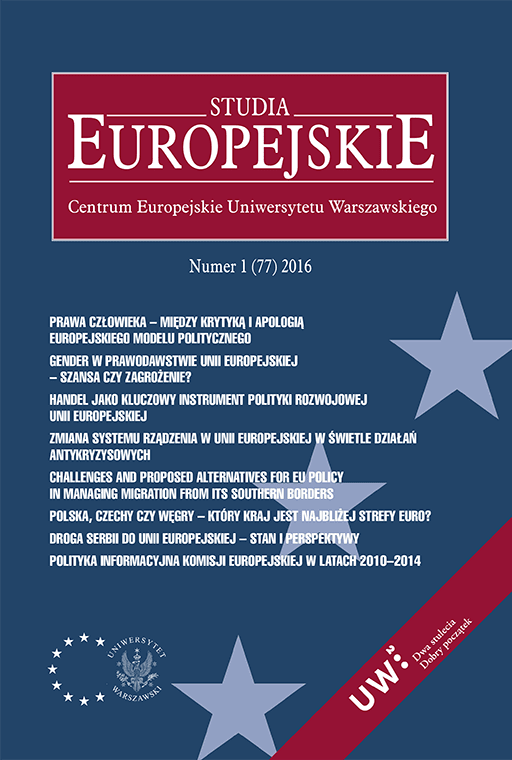
ISSUE: 1/2016
- Volume 77
- Number 1
- 2016
Subscribe NEWSLETTER
Studia Europejskie –
Studies in European Affairs
ISSN: 1428-149X
e-ISSN: 2719-3780
License
Articles published in the journal are under a Creative Commons Attribution – Non Commercial – No Derivatives 4.0 International License
Polska, Czechy czy Węgry – który kraj jest najbliższy strefy euro?
Poland, the Czech Republic or Hungary – Which Country is the Closest to the Euro Zone?
Abstract
The aim of the article is to show the issue connected with adjustments of the Polish, Hungarian and Czech economies to the euro area in the context of the nominal Maastricht convergence criteria (in the years 2004–2013 and, in some cases, also in the first months of 2014). Taking into account those criteria and legislation, the analysis shows that, among the above-mentioned countries, it is the Czech Republic that is closest to the euro zone, followed by Poland and Hungary. It is concluded, however, that none of those countries will probably be interested in replacing the national currency with the euro anytime soon.
References
Booth P., Introduction, w: The Euro. The Beginning, the Middle… and the End?, red. P. Booth, the Institute of Economic Affairs, London 2013.
Bonefeld W., European Monetary Union: Ideology and Class, w: The Politics of Europe. Monetary Union and Class, red. W. Bonefeld, Palgrave, Antony Rowe Ltd, Chippenham, Wiltshire 2001.
Bukowski S.I., Unia monetarna. Teoria i polityka, Difin, Warszawa 2007.
Convergence Report 2004; European Central Bank, Frankfurt am Main 2004.
Convergence Report. December 2006, European Central Bank, Frankfurt am Main 2006.
Convergence Report. May 2008, European Central Bank, Frankfurt am Main 2008.
Convergence Report. May 2010, European Central Bank, Frankfurt am Main 2010.
Convergence Report. May 2012, European Central Bank, Frankfurt am Main 2012.
Convergence Report. June 2014, European Central Bank, Frankfurt am Main 2014.
Ekonomiczne wyzwania integracji Polski ze strefą euro, NBP, Warszawa 2014.
Europejski Bank Centralny. Eurosystem. Europejski System Banków Centralnych, Europejski Bank Centralny, Frankfurt nad Menem 2006.
Gadomski W., Jak Victor Orban kupuje Węgrów, „Gazeta Wyborcza”, 19.09.2013.
http://ec.europa.eu/eurostat/tgm/table.do?tab=table&init=1&language=en&pcode=tec00033&plugin=1 [dostęp 2.04.2015].
http://wyborcza.biz/biznes/1,100896,15203744,Kto_nastepny_do_strefy_euro__Po_Lotwie_Litwa__a_potem___.html#ixzz3XDN05YhX [dostęp 2.04.2015].
Jasiński L.J., Makroekonomiczny wymiar integracji, w: M. Belka, J. Hausner, L.J. Jasiński, M. Marody, M. Zirk-Sadowski, Polska transformacja w perspektywie integracji europejskiej, EU – monitoring, Warszawa 1996.
Karnowski J., Polityka gospodarcza Hiszpanii, Portugalii i Grecji w drodze do Unii Gospodarczej i Walutowej. Analiza doświadczeń na tle teorii „Materiały i Studia”, z. 199/2006.
Osiatyński J., Warunki gotowości Polski do wejścia do strefy euro, „Ekonomista”, nr 5/2011.
Pietrucha J., Awersja infl acyjna a niezależność banku centralnego w krajach transformacji systemowej, w: Polityka gospodarcza państwa, red. D. Kopycińska, Wydawnictwo PRINT GROUP Daniel Krzanowski, Katedra Mikroekonomii, Uniwersytet Szczeciński, Szczecin 2007.
Szasz A., The Road to European Monetary Union, Antony Rowe Ltd, Chippenham, Wiltshire 1999.
Szeląg K., Strategia jednolitej polityki pieniężnej w strefi e euro – kluczowe elementy i zasady, „Materiały i Studia”, nr 162/2003.
Żyżyński J., Wejście do strefy euro – od iluzji do konkretów, „Ekonomista”, nr 5/2009.
Language: Polish
Pages: 119-136
How to Cite:
Harvard
Grabia, T. (2016) "Polska, Czechy czy Węgry – który kraj jest najbliższy strefy euro?". Studia Europejskie – Studies in European Affairs, 1/2016, pp. 119-136.